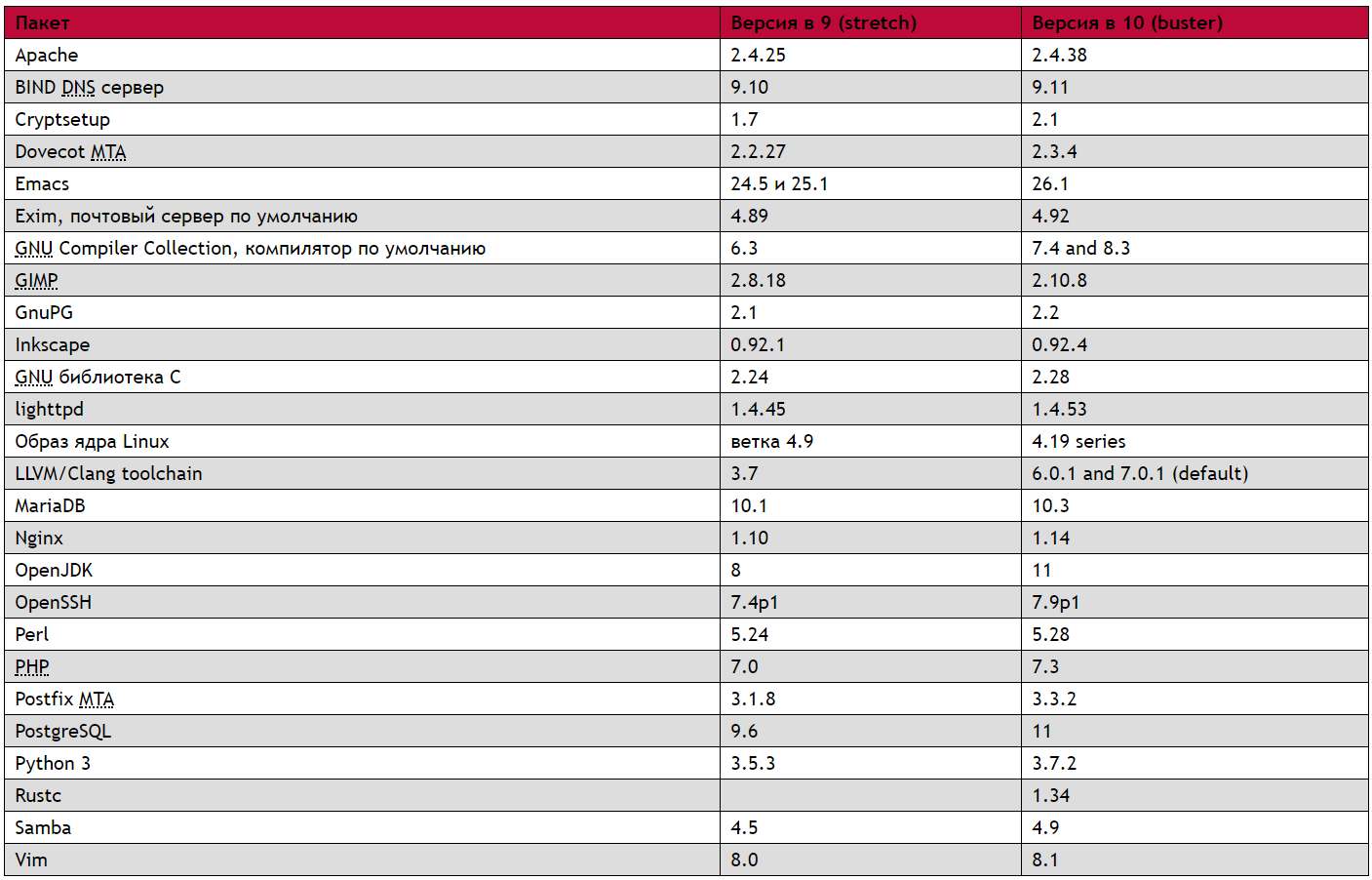Debian 10 Buster and Linux 5.2 Released
At the end of last week, two important releases for the community took place at once: the jubilee version of Debian 10 saw the light, which, following tradition, was named “Buster”, as well as the new version of Linux 5.2.

So, the new Debian distribution boasts an increment of more than 13370 packages in its system (their total number is now 57 thousand). At the same time, 7278 packages were removed from the system (13% of the total volume of the previous version). All of them are not subject to updating and received a mark "outdated".
The new version of Linux brought us a new Open Sound firmware, mount API, updated GPU drivers for ARM Mali devices, and support for case-insensitive names for the ext4 file system.
Full patch notes can be found at:
Debian 10 Buster
Linux 5.2
And about the most basic details - under the cut.
In our blog, we already came into contact with the Debian distribution by translating the blog post of one of the leading GO developers of the project team , in which the latter revealed the main development problems. But no matter how Michael Stapelberg was not dissatisfied with the current state of affairs in the Debian developer community, the distribution continues to develop, and the new Debuan 10 Buster update brought us a lot of important things.
Below is a complete comparison table of Debian 10 Buster updates regarding Debian 9 Stretch (clickable): First of all, it is worth highlighting that the firewall management system has been changed from to . At the same time, for those who wish, the possibility of using with . Compared to , the system

The default installation of the Gnome environment has also changed. Now, by default, the session based on the Wayland protocol is involved in this process, but the developers have maintained support for the X11-based session for those who wish.
Also, since the introduction of Debian 7 in 2013, for the first time for new Debian installations, the access control system for AppArmor applications has been enabled by default. True, out of the box this system works with an extremely limited number of applications, but the user can always load additional profiles through the installation of the package
Updating the kernel is always important, especially if it is the Linux kernel. In the new version of Linux 5.2, the developers themselves emphasize improved support for audio devices using Sound Open Firmware. But there are other important things in the latest update.
So, we highlighted the new Mount API. Many users may not notice the difference, but this update is important from the infrastructure side of the issue. Apparently, the development team was engaged in cleaning garbage and rewriting mounts responsible for mounting file systems. The existing Mount interface looks like an old layer cake: this system has evolved over the years, has been overgrown with new functions and tasks, so at some point it has turned into something too complicated. In order to make life easier for users and save them from having to use crutches of the kindShiftfs , six new system calls have been added:
The next major update is a set of drivers for ARM Mali devices. One of the oldest threads on the w3bsit3-dns.com forum on installing Linux on a device with an ARM Mali graphic core dates back to 2013, and many dances with a tambourine are described inside. Then even partial operation of the video chip under Linux was considered a success.
Much of the blame for the many years of suffering for users lies with ARM itself, which is not too willing to work with the Open Source community, but Linux developers went their own way and wrote the drivers themselves. The new package supports older t4xx devices, as well as the newer 6xx and 7xx series. Of course, this is far from complete support (there are also a series of
We also mentioned
In general, the patch laptop for Linux 5.2 is very extensive. It describes the changes in the operation of file systems, memory management, networking, compatibility with ARM and so on and so forth. So those who communicate tightly and comprehensively with Linux should familiarize themselves with the full patch laptop .

So, the new Debian distribution boasts an increment of more than 13370 packages in its system (their total number is now 57 thousand). At the same time, 7278 packages were removed from the system (13% of the total volume of the previous version). All of them are not subject to updating and received a mark "outdated".
The new version of Linux brought us a new Open Sound firmware, mount API, updated GPU drivers for ARM Mali devices, and support for case-insensitive names for the ext4 file system.
Full patch notes can be found at:
Debian 10 Buster
Linux 5.2
And about the most basic details - under the cut.
What's New in Debian 10 Buster
In our blog, we already came into contact with the Debian distribution by translating the blog post of one of the leading GO developers of the project team , in which the latter revealed the main development problems. But no matter how Michael Stapelberg was not dissatisfied with the current state of affairs in the Debian developer community, the distribution continues to develop, and the new Debuan 10 Buster update brought us a lot of important things.
Below is a complete comparison table of Debian 10 Buster updates regarding Debian 9 Stretch (clickable): First of all, it is worth highlighting that the firewall management system has been changed from to . At the same time, for those who wish, the possibility of using with . Compared to , the system

netfilterIptablesNftablesIptablesiptables-legacyIptablesNftableshas much greater performance. In addition, it has updated syntax, improved support for IPv4 / IPv6 dual-stack firewalls, there is an interface Netlinkfor working with third-party applications, and faster classification of packets based on an expanded universal set of infrastructure cards is implemented. You Nftablescan read about all the differences here . The default installation of the Gnome environment has also changed. Now, by default, the session based on the Wayland protocol is involved in this process, but the developers have maintained support for the X11-based session for those who wish.
Also, since the introduction of Debian 7 in 2013, for the first time for new Debian installations, the access control system for AppArmor applications has been enabled by default. True, out of the box this system works with an extremely limited number of applications, but the user can always load additional profiles through the installation of the package
apparmor-profiles-extra. The latter is recommended for execution by the Debian developers themselves. Although AppArmor is a rather old tool, it allows you to differentiate application access in terms of resources and privileges ( mount, ptrace, signal permissions, read, write, execute access), which twenty years after the release of the first version in 1998 is extremely important. So the recommendations of the Debian team should not be ignored.What's New in Linux 5.2
Updating the kernel is always important, especially if it is the Linux kernel. In the new version of Linux 5.2, the developers themselves emphasize improved support for audio devices using Sound Open Firmware. But there are other important things in the latest update.
So, we highlighted the new Mount API. Many users may not notice the difference, but this update is important from the infrastructure side of the issue. Apparently, the development team was engaged in cleaning garbage and rewriting mounts responsible for mounting file systems. The existing Mount interface looks like an old layer cake: this system has evolved over the years, has been overgrown with new functions and tasks, so at some point it has turned into something too complicated. In order to make life easier for users and save them from having to use crutches of the kindShiftfs , six new system calls have been added:
fsopen (2), fsconfig (2), fsmount (2), move_mount (2), fspick (2) и open_tree (2). How to use the new challenges right here . The next major update is a set of drivers for ARM Mali devices. One of the oldest threads on the w3bsit3-dns.com forum on installing Linux on a device with an ARM Mali graphic core dates back to 2013, and many dances with a tambourine are described inside. Then even partial operation of the video chip under Linux was considered a success.
Much of the blame for the many years of suffering for users lies with ARM itself, which is not too willing to work with the Open Source community, but Linux developers went their own way and wrote the drivers themselves. The new package supports older t4xx devices, as well as the newer 6xx and 7xx series. Of course, this is far from complete support (there are also a series of
8xxand Gxx), but already something. On the blog itself, the developers hope that their work will help ARM , which in our opinion is very subtle. We also mentioned
case-insensitivename support for the file system.ext4, or, to put it bluntly, support for case-insensitive names in the ext4 file system. The latter can be called a full-fledged change in the kernel of the Linux system and an important one. Now, for successful name matching, you do not need a complete byte matching of strings - just matching the names in is enough Unicode, which will really appeal to Fans of Using Register . In general, it is recommended to read the corresponding article “Case-insensitive ext4” on this topic . In general, the patch laptop for Linux 5.2 is very extensive. It describes the changes in the operation of file systems, memory management, networking, compatibility with ARM and so on and so forth. So those who communicate tightly and comprehensively with Linux should familiarize themselves with the full patch laptop .
